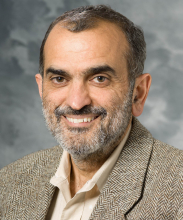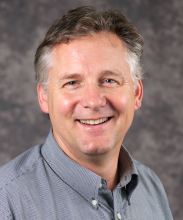

This week, we speak with Dr. Shahriar Salamat and Mr. Jay Fruehling to discuss brain donation research and how it helps give the most accurate diagnoses. Guests: Dr. Shahriar Salamat, professor in the Department of Pathology, University of Wisconsin School of Medicine and Public Health and Mr. Jay Fruehling, Wisconsin Brain Bank Program Manager and community educator on brain donations at the Wisconsin Alzheimer's Disease Research Center
Subscribe to this podcast through iTunes, Spotify, Podbean, Stitcher, or Google Play Music.
Show Notes
Learn more about brain donation at the Wisconsin Brain Donor Program website, or view an informational brochure about the Wisconsin Brain Donor Program.
Transcript
Intro: Welcome to Dementia Matters, a podcast presented by the Wisconsin Alzheimer's Disease Research Center. Our podcast is here to educate you on the latest research, caregiver strategies, and available resources for fighting back against Alzheimer's disease. I'm your host, Nathaniel Chin. Thanks for joining us.
Dr. Nathaniel Chin: Welcome to Dementia Matters. I'm here with Dr. Shahriar Salamat, a professor in the Department of Pathology and Laboratory Medicine, course director of the pathophysiologic principles of human disease at the UW School of Medicine and Public Health, and the co-leader of the Neuropathology Core here at the Wisconsin Alzheimer's Disease Research Center. We're joined by Mr. Jay Fruehling, the Brain Bank Program Manager and the community educator on brain donations at the Wisconsin ADRC. Welcome to you both.
Jay Fruehling: Thank you. It's nice to be here.
Dr. Shahriar Salamat: Yes, it's very nice to be here.
Chin: Well, let me start by asking, what is the Wisconsin Brain Donor Program and why is it so important to Alzheimer's disease research?
Salamat: Well, the program is intended to collect brain tissue, fresh brain tissue from patients who are enlisted as participants in our studies. And as you know, we have the Alzheimer's disease research that goes on -- ADRC -- here. We also have the Wisconsin Registry for Alzheimer's Prevention (WRAP) and Alzheimer's Disease and Neuroimaging Initiative, which is called the ADNI. So essentially we collect brain tissue from these individuals in a fresh state and parcelize it. Part of it goes for diagnosing the exact disease state of each individual, and another part of it is kept frozen for the scientists who approach us and want to do studies in the neurodegenerative diseases, Alzheimer's disease and alike.
Chin: I see. So part to confirm what we've been saying about their clinical diagnosis, parts saved and frozen for research purposes.
Salamat: That's correct. That's correct. So in order to provide the scientists with standard tissue that they can depend on the type of tissue they're examining, we do have to examine the brain from a pathological point of view, give precise or accurate diagnosis for the disease they have so that then the scientists can select the type of tissue they want for a specific interest of their research.
Chin: And the people in the brain donation program are very invested in what you guys do. And so I wonder, how can other people get involved? How can they donate their brains to the Wisconsin Brain Donation Program?
Salamat: Basically, as I mentioned, we collect brains of patients who are in ADRC, WRAP and ADNI -- all of those three study groups -- and we mainly concentrate on collecting those brains because our brain bank or Wisconsin Brain Donor Program is in a large part funded by federal grants. So we do need to include the patients who are part of federally funded studies. So we have some limitations as who we can take. So if somebody is interested to be a donor, they needed to be a participant in a study. That way during their life, the clinicians, psychiatrists, physicians can evaluate their mental status, their cognitive ability, their memory ability, they can follow them throughout the years, and once they pass on, their brain is an important resource for research because we know what the course of life was for them from a clinical point of view, and now we have golden standard of diagnosis by examining their brain, then that brain tissue becomes ideal. One thing I want to add is we do make a particular exception for normal brains. Normal brains, control brains, in order to compare with the disease brain or actually rare in brain banks. So we do, go out of our way to accept brain from individuals who have no clinical or no history of dementia, neurodegenerative disease, and so forth.
Chin: Okay, and Dr. Salamat , what are we hoping to accomplish from collecting these brain samples?
Salamat: Even in the most advanced setting, still about 10% to 15% of the patients who have an Alzheimer's Disease diagnosis clinically end up not to have Alzheimer's disease as the main cause of their dementia or neurodegenerative disease. That's the first thing we do, we identify the exact disease which is affecting the individual's brain, and that becomes clearer for the family. It also has future implications for the family because as we learn more about genetics and more about the diagnosis of Alzheimer's disease, the children of individuals who have had Alzheimer's disease or other neurodegenerative disease will have died, those children may in the future have potential for receiving medications which will help them, or if they have concerns, those concerns may be, in fact alleviated based on what diagnosis we get. So there is a future implication to this.
Chin: I really appreciate your answer and that we are a research center and we are so grateful for people to give for research, but you really highlighted the benefit that people receive in giving -- that they get a diagnosis that is the gold standard and that there are future implications to that. Which really leads to my next question. Why is an autopsy, why is pathology, the gold standard?
Salamat: Well, as of this point, there is no precise way to diagnose every case of dementia or every case of Alzheimer's disease. We do very well. As I mentioned, for instance, in patients with Alzheimer's disease in about 80% to 85% or so, we have good confidence in our clinical diagnosis. And about 10%, 15%, maybe a little bit higher percentage as in either institutions, their confidence is not there. But in addition, there are multiple other neurodegenerative diseases that can co-exist with Alzheimer disease. Probably commonly know to people here -- dementia with Lewy bodies or vascular dementia. Sometimes these other entities are as much influencing the degree of loss of function and memory and cognitive impairment in a person, and sometimes they are contributing to a lesser degree, or at times more so than Alzheimer's disease for instance. So by doing the autopsy and looking at the brain, we can figure out what is the burden of each of those diseases because as of this point, we don't have any clinical tool to do that precisely. So autopsy does remain a gold standard.
Chin: Can you walk us through what an autopsy entails? What do you look for it?
Salamat: Of course, this is an autopsy, which is the limited to brain examination. So the first thing which happens is there is a family member or a loved one who calls us and notifies Jay or Rachel of a potential death or impending death or death which has just occurred. So then Jay and Rachel, they start quickly by making sure that the family and their funeral home make the arrangement for the body to be brought to our autopsy surface. Then I meet with either of them, Jay or Rachel, and we proceed to remove the brain. There is an incision made on the scalp, which for those people who want to go to viewing for the funeral process, that incision is not visible. We make an incision in the scalp, we make an incision in the calvaria bone -- the skull -- and we remove the brain. As soon as we remove the brain, we record its fresh weight and then we divided the brain into two hemispheres -- a right and a left hemisphere. Traditionally at our brain bank, we have sliced right away the right hemisphere and frozen it according to a very specific protocol that ensures a freshness of the tissue. The left hemisphere is fixed in formalin and we examine it in about 10 to 14 days. After it has been fixed in formalin, we examine it grossly by inspecting it, slicing it further looking for potential infarcts, tumors or other lesions, other changes related to neurodegenerative disease. Then we take extensive sampling of that brain from multiple different areas of the brain, and those tissues go for paraffin embedment -- that means they get embedded in paraffin -- so that they can be sectioned very thinly. Those thin sections are then stained. And we use multiple different stains and immunohistochemistry or antibodies -- these are antibodies which are directed, for instance, against Beta amyloid protein or tau protein to help us identify their presence, their distribution, and their concentration. So ultimately after all of these studies are done, I sit and look at the entire tissue, I use the NIA criteria to score the tissue findings, and then produce a report. And then through Jay's and Rachel's help, we make sure that this report is available to the family and then we all are available to the family to answer their questions after they get the report. We sometimes meet by way of just telephone conversation or in person with the family.
Chin: For people listening that are not a part of those studies that were mentioned, and they were interested in being and having a donation, brain donation or an autopsy. What do they do?
Fruehling: It is very difficult to find a home of this gift from someone with Alzheimer's disease who is not part of a research study. The research is advancing, and that's a good thing. So, these 32 Alzheimer's centers, they do pretty much across the board limit to their study participants like we do, or perhaps to a certain geographic region. So if one is not part of a research study, they can, you can still seek out a brain only autopsy to get answers. If you happen to live near a large teaching hospital, it may be that the autopsy would be provided free of charge, for example. That is the case at the UW Hospital, for our patients. And so talk to your doctor and see if, if he or she recommends an autopsy, a brain only autopsy, and then that can be pursued independent of any brain donation through the Department of Pathology, for example, or the UW hospital mortician.
Chin: Well, I really want to thank you both for coming here and speaking on Dementia Matters. And as more studies come out and, and as we have more findings and the pathological world, I welcome you back for another episode.
Outro: Dementia Matters is brought to you by the Wisconsin Alzheimer's Disease Research Center. The Wisconsin Alzheimer's Disease Research Center combines academic, clinical, and research expertise from the University of Wisconsin School of Medicine and Public Health and the Geriatric Research Education and Clinical Center of the William S. Middleton Memorial Veterans Hospital in Madison, Wisconsin. It receives funding from private, university, state, and national sources, including a grant from the National Institutes of Health for Alzheimer's Disease Centers. This episode was produced by Rebecca Wasieleski and edited by Bashir Aden. Our musical jingle is "Cases to Rest" by Blue Dot Sessions. Check out our website at adrc.wisc.edu. You can also follow us on Twitter and Facebook. If you have any questions or comments, email us at dementiamatters@medicine.wisc.edu. Thanks for listening.



